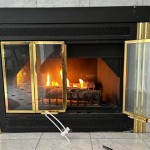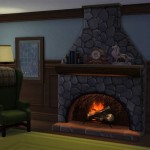Heatilator Gas Fireplace Blower: Enhancing Fireplace Efficiency and Comfort
A Heatilator gas fireplace often serves as a focal point in a living space, providing warmth and ambiance. While the gas fireplace itself generates heat, a fireplace blower, also known as a fan kit, can significantly improve its efficiency and effectiveness in distributing that heat throughout the room. This article will explore the benefits, operation, selection, installation, and maintenance aspects of a Heatilator gas fireplace blower, providing a comprehensive understanding of its role in optimizing the fireplace experience.
Understanding the Function of a Fireplace Blower
A gas fireplace, unlike a traditional wood-burning fireplace, typically operates with a sealed combustion chamber. This design enhances safety and efficiency but can also limit the natural convection of heat. The heat generated by the gas flames primarily radiates outwards, warming objects and individuals directly in front of the fireplace. A considerable amount of heat, however, can remain trapped within the fireplace enclosure.
A fireplace blower addresses this limitation by actively circulating air through the fireplace unit. The blower, typically a centrifugal fan, pulls cooler air from the room, directs it through the heated firebox or heat exchanger, and then forces the warmed air back into the room. This forced convection process significantly improves heat distribution, ensuring a more even temperature throughout the space and reducing temperature stratification (where hot air rises to the ceiling while the floor remains cold).
The increased air circulation provided by the blower helps to extract more heat from the fireplace unit, maximizing its heating potential. This results in a more comfortable and consistent room temperature, and potentially reduces the reliance on the primary heating system, leading to energy savings.
Benefits of Installing a Heatilator Gas Fireplace Blower
Integrating a blower into a Heatilator gas fireplace offers numerous advantages in terms of comfort, efficiency, and cost-effectiveness. These benefits contribute to a more satisfying overall fireplace experience.
Enhanced Heat Distribution: As previously discussed, the primary benefit of a blower is improved heat circulation. Without a blower, the heat from the fireplace tends to concentrate near the unit, creating a localized warm zone. The blower actively combats this by distributing the warm air further into the room, reaching corners and remote areas that would otherwise remain cooler. This ensures a more consistent and comfortable temperature throughout the entire living space.
Increased Heating Efficiency: A blower helps to extract more heat from the fireplace's heat exchanger or firebox. By forcing air through these heated areas, the blower maximizes heat transfer, preventing heat from simply dissipating into the fireplace enclosure. This increased efficiency translates into more usable heat output for the same amount of gas consumed, potentially leading to lower heating bills.
Faster Room Warm-up: The forced convection provided by a blower allows for a quicker room warm-up time compared to natural convection alone. When the fireplace is first turned on, the blower can quickly circulate the initial surge of heat, bringing the room to a comfortable temperature faster. This is particularly beneficial in colder climates or when a quick burst of heat is desired.
Reduced Energy Consumption: While the blower itself consumes a small amount of electricity, the overall effect can be a reduction in energy consumption. By more efficiently heating the target area, the reliance on the home's central heating system can be reduced. The thermostat can be set lower, knowing that the fireplace blower will effectively distribute the heat it generates. This can lead to noticeable savings on heating bills over time.
Improved Comfort Levels: The even distribution of heat creates a more comfortable and inviting environment within the room. Eliminating cold spots and temperature fluctuations enhances the overall indoor comfort, making the living space more enjoyable, especially during colder months.
Selecting the Right Blower for a Heatilator Gas Fireplace
Choosing the correct blower for a specific Heatilator gas fireplace model is crucial for optimal performance and compatibility. Several factors must be considered during the selection process to ensure that the chosen blower meets the fireplace's requirements and the user's expectations.
Compatibility: The first and most important consideration is compatibility with the specific Heatilator gas fireplace model. Fireplace manufacturers design blowers to fit specific firebox dimensions and airflow requirements. Using a blower that is not designed for the fireplace can lead to poor performance, overheating, or even damage to the fireplace or blower itself. Consult the Heatilator fireplace's owner's manual or the manufacturer's website for a list of compatible blower models. Utilizing the correct blower guarantees proper fit and functionality within the fireplace enclosure.
Airflow Capacity (CFM): Blower airflow capacity is measured in Cubic Feet per Minute (CFM). This rating indicates the volume of air the blower can move per minute. A higher CFM rating generally means more powerful airflow and faster heat distribution. The required CFM will depend on the size of the room to be heated and the heating capacity of the fireplace. Owner's manuals usually provide guidelines for selecting the appropriate CFM based on fireplace BTU output and room size. Overestimating the CFM can result in excessive noise, while underestimating it can lead to inadequate heat distribution.
Noise Level: Blower noise is an important consideration, especially for those sensitive to sound. Blower noise is typically measured in decibels (dB). A lower dB rating indicates a quieter blower. Many blower manufacturers provide noise level ratings for their products. When selecting a blower, consider the desired level of quietness and choose a model that meets those needs. It's also worth noting that some blowers offer variable speed control, allowing users to adjust the airflow and noise level to their liking.
Variable Speed Control: Some blowers offer variable speed control, which allows users to adjust the airflow and noise level. This feature can be beneficial for fine-tuning the heating output and comfort level. Lower speeds can be used for gentle heat distribution and reduced noise, while higher speeds can be used for faster warm-up and maximum heat output. Variable speed control provides greater flexibility and customization.
Features and Controls: Consider any additional features or controls that may be desirable. Some blowers come with automatic temperature sensors that turn the blower on and off based on the fireplace's temperature. Others have remote controls for convenient operation. Evaluate the available features and choose a blower that meets the individual's needs and preferences.
Installation of a Heatilator Gas Fireplace Blower
The installation process for a Heatilator gas fireplace blower can vary depending on the specific fireplace model and the design of the blower kit. While some installations are straightforward and can be performed by homeowners with basic mechanical skills, others may require professional installation. It's essential to carefully follow the manufacturer's instructions and prioritize safety throughout the installation process.
Safety Precautions: Before starting any installation work, it's crucial to disconnect the gas supply to the fireplace and turn off the electrical power to the unit. Allow the fireplace to cool completely before handling any components. Wear appropriate safety gear, such as gloves and eye protection. If unsure about any aspect of the installation process, it's always best to consult a qualified technician.
Refer to the Manufacturer's Instructions: The manufacturer's instructions provide detailed step-by-step guidance for installing the specific blower kit. These instructions should be followed carefully and precisely. The instructions will typically include diagrams and illustrations to aid in understanding the installation process.
Accessing the Blower Compartment: Depending on the fireplace model, accessing the blower compartment may involve removing the lower louvers, panels, or other components of the fireplace. Refer to the instructions for the specific steps required to access the blower compartment.
Connecting the Blower: The blower will typically mount into a designated location within the fireplace enclosure using screws or clips. Ensure that the blower is securely mounted and properly aligned. Connect the blower's electrical wiring to the fireplace's wiring harness, following the manufacturer's instructions. Pay close attention to polarity and grounding requirements.
Testing the Blower: After completing the installation, carefully inspect all connections and components. Turn on the electrical power to the fireplace and test the blower. Verify that the blower operates smoothly and quietly. Ensure that the airflow is directed correctly. If any issues are encountered, consult the manufacturer's instructions or contact a qualified technician.
Maintaining a Heatilator Gas Fireplace Blower
Proper maintenance is essential for ensuring the long-term performance and reliability of a Heatilator gas fireplace blower. Regular cleaning and inspections can help to prevent issues and extend the lifespan of the blower.
Cleaning: Dust accumulation can significantly reduce the blower's efficiency and potentially cause overheating. Periodically clean the blower blades and motor housing using a soft brush or vacuum cleaner. Disconnect the power to the fireplace before cleaning. Be careful not to damage any delicate components during the cleaning process. The frequency of cleaning will depend on the environment and usage patterns, but typically cleaning once or twice a year is sufficient. If there are pets in the house that shed hair, the blower will mostly need to be cleaned more often.
Inspections: Regularly inspect the blower for any signs of damage or wear. Check the wiring connections for looseness or corrosion. Listen for any unusual noises during operation. If any issues are detected, address them promptly to prevent further damage. Replace any worn or damaged parts as needed.
Lubrication: Some blower motors may require occasional lubrication. Consult the manufacturer's instructions to determine if lubrication is necessary and what type of lubricant to use. Applying the correct lubricant can help to extend the life of the motor. This is not a common issue with modern blowers that usually have sealed bearings that need no lubrication.
Professional Servicing: Consider having the fireplace and blower professionally serviced annually. A qualified technician can perform a thorough inspection, cleaning, and tune-up to ensure optimal performance and safety. Professional servicing can also identify and address any potential issues before they become major problems.

Installing A Fireplace Blower Gfk4 Gfk4a In Heatilator Natural Gas

Heatilator Fireplace Blower Fan Kit Gfk4b Hearth Trends

Gfk21 Fk21 Replacement Fireplace Blower Fan Kit For Heatilator Majestic Vermont

Blower Kit For Heatilator Fireplaces Gfk4

Fireplace Blower Fan Replacement Kit For Heatilator Majestic Temco Lennox Rotom

Heatilator Heat N Glo Factory Oem Fireplace Blower Kit Fk18 Com

Blower For Heatilator Gas Fireplaces Gfk 4 Only

Heat N Glo Heatilator 046 530 Temperature Sensor Switch Gas Fireplace Fan Blower

Gfk 210 Blower System Heatilator Fireplaces

Heatilator Blwr 4b Fireplace Blower Fan Hearth Trends
Related Posts








